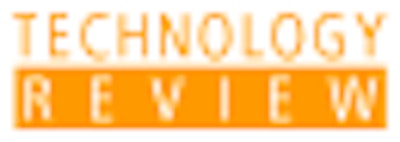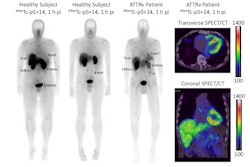

These prospects have prompted scanner manufacturers to introduce two new hybrid SPECT/CT systems. The Siemens Medical Solutions (Malvern, PA) offering is the Symbia TruePoint and the Philips Medical Systems (Andover, MA) device is named Precedence.
The Siemens system builds on its successful e.cam platform, and the Philips system is designed around its high-end Skylight SPECT nuclear camera, which utilizes an overhead suspension for the camera heads. Although a hybrid SPECT/CT, the Infinia Hawkeye, has been available from GE Healthcare (Chalfont St. Giles, U.K.) for a number of years, the CT images are not considered diagnostic quality, but do provide an anatomic reference for the SPECT image.
An important factor in the success of PET/CT was that it introduced an image format familiar to radiologists, while adding important anatomic information regarding metabolically active tissue. The concept was originally sold to radiologists as CT imaging enhanced with PET as a contrast agent. One effect was that it brought radiologists and nuclear physicians closer together, and it also helped referring physicians understand the information conveyed by the images. This added confidence in the overall diagnostic workup.
Differences between PET and SPECT
SPECT imaging offers certain advantages over PET in that many SPECT agents have more specific targeting capabilities than FDG agents. Several SPECT radiopharmaceuticals incorporate antibody and peptide formulations that can be targeted to specific tissue receptors, allowing one to discriminate healthy from diseased tissue with a high confidence level.
However, the more specific the targeting agent, the more difficult it is to interpret its position anatomically, since there are fewer landmarks. This can make it difficult for the average physician to interpret certain SPECT images.
FDG, on the other hand, is a broad-spectrum agent that only images metabolic activity. FDG lights up healthy tissue as well as diseased tissue, but the diseased tissue has higher brightness because of higher metabolic activity. Whereas this can often be used to distinguish diseased from healthy tissue (as in malignant tumors), it is an indirect indication of disease.
In the case of SPECT, the addition of CT may achieve some of the same advantages as it has with PET, allowing one to carefully analyze the extent and location of radiopharmaceutical uptake, improving diagnostic accuracy. This has already been demonstrated with targeted oncology radiopharmaceuticals such as OctreoScan (Mallinckrodt, Hazelwood, MO) and ProstaScint (Cytogen, Princeton, NJ).
Justifying reimbursement for these procedures at a level similar to PET has also been possible. This has encouraged manufacturers of these radiopharmaceuticals to increase their promotional efforts and expand training programs to include fusion imaging.
SPECT is also based primarily on radiopharmaceuticals such as technetium that have a relatively slow decay rate compared with FDG. This simplifies the logistics of handling SPECT agents compared with PET.
Potential applications of SPECT/CT
Nuclear medicine procedures can be classified in three major groups: nuclear cardiology, general nuclear medicine for functional imaging, and targeted oncology. In 2004 there were 15.8 million SPECT procedures comprised of 8 million nuclear cardiology procedures, 7.8 million general nuclear medicine procedures, and about 25,000 targeted cancer imaging procedures.
In comparison, about 1 million PET procedures were performed in 2004. The most important PET application is in oncology, where whole-body imaging is used effectively to identify tumors at their source and scan for metastatic disease that might be remote from the source.
SPECT, on the other hand, is more focused on organ function, such as the heart, lungs, kidneys, gall bladder, liver, and thyroid. Although some SPECT procedures utilize whole-body scanning, such as bone scans, these are not as specific as many of the organ studies.
SPECT/CT in cardiology
Whereas PET/CT has a natural fit in oncology, the opportunities for SPECT/CT have to be considered quite differently. SPECT imaging is strongly driven by cardiology, primarily nuclear perfusion studies.
Growth in interventional cardiology and angioplasty procedures has required tracking patients with nuclear medicine for an extended period of time to ensure that cardiac function has not been compromised by disease recurrence. From this standpoint, anything that can be done to improve the information yield from these procedures and reduce the number of inconclusive SPECT studies can be clinically and economically justified. SPECT/CT may be able to accomplish this by adding certain vital information that will reduce the number of equivocal studies in difficult cases.
Cardiologists have recognized the benefits of utilizing CT for detecting coronary calcification. Calcium scoring has become an accurate noninvasive test for early detection of coronary atherosclerosis and consequent stenosis. When coupled with SPECT perfusion imaging, it increases the accuracy in diagnosing and treating patients with these indications.
Where perfusion abnormalities are revealed with SPECT, it would be clinically useful to augment this information with CT angiography, revealing the cause of the perfusion deficiency. Myocardial perfusion imaging has a high success rate in indicating which patients are likely to benefit from revascularization or angioplasty, but it doesn't detect early atherosclerosis and has a tendency to underestimate the extent of coronary artery disease. In advanced disease, there may be multiple causes for perfusion defects, and the additional information from CT would allow more specific diagnosis and treatment.
From this standpoint, SPECT/CT should incorporate multislice CT technology capable of functioning in a cardiology environment. This requires 16-slice CT, which puts these systems at the high end of the price spectrum. However, it is likely that applications in cardiology will provide enough patient referrals to justify the investment. The slower systems, such as two-slice or six-slice CT, will not fill the same need in cardiology and may be limited to other nuclear medicine areas in which the procedure volume is much lower.
SPECT/CT in general nuclear medicine
SPECT/CT should find applications in general nuclear medicine where anatomic localization is important, such as infection imaging. The first in vivo infection imaging agent, NeutroSpec (Palatin Technologies, Cranbury, NJ), was approved in 2004, with primary indication in imaging appendicitis.
NeutroSpec is a targeted monoclonal antibody that has an affinity for granulocytes that accumulate at the site of infection. Patients who present with abdominal pain are often difficult to diagnose because the symptoms are indiscreet. In vivo infection imaging augmented with CT could help clinicians accurately locate the source of infection and improve the sensitivity of diagnosis.
Traditional infection imaging using the patient's white blood cells labeled in vitro might also benefit from CT's capability to provide accurate anatomic localization. This could help diagnose diffuse infection sites and assist in analyzing fever of unknown origin. There were about 100,000 of these procedures performed in 2004.
Lung imaging is another area that may be a fit for SPECT and CT. About 2 million lung scans were performed in 2004, with a strong focus on pulmonary embolism.
The nuclear ventilation/perfusion (V/Q) scan has become standard for distinguishing ventilation defects from pulmonary embolism. This is accomplished by comparing the ventilation and perfusion scans for mismatches. If there is a mismatch between the two scans, pulmonary embolism is suspected. However, the image quality of these scans is often poor, and the addition of CT could substantially increase diagnostic accuracy.
SPECT/CT in neurology
SPECT has had limited application in neurology. However, emerging SPECT agents for imaging Parkinson's disease could be augmented with CT to improve diagnostic accuracy. This would allow nuclear physicians to read the SPECT images more clearly by being able to analyze the symmetry of the radiopharmaceutical uptake in the two halves of the brain and better distinguish the presence of disease.
One agent, I-123 Altropane (Boston Life Sciences, Boston), has completed one phase III clinical trial and is currently being studied in a second phase III trial under a special protocol assessment (SPA) with the Food and Drug Administration to determine its potential use in differentiating Parkinsonian from non-Parkinsonian tremors. Neurologists have recognized the importance of distinguishing Parkinson's from diseases with similar outward symptoms, such as basic tremor and cases of Alzheimer's disease with tremor. Therefore, a definitive diagnosis is critical in selecting the proper course of treatment.
Oncology applications
Although there is a logical fit for SPECT/CT in oncology, the number of procedures with targeted agents, such as OctreoScan for imaging endocrine tumors, ProstaScint for prostate imaging, and NeoTect (Berlex Imaging, Wayne, NJ) for lung imaging, has been limited.
In addition, PET/CT has preempted many oncology SPECT procedures because of the universal nature of FDG and the strong referral patterns established through radiology. Although there is an opening for SPECT/CT in oncology, it would not offer enough justification to make the investment without other prospects with higher procedure volume, such as cardiology and areas of general nuclear medicine referenced earlier.
The learning curve
Equipment manufacturers often have to invest in new technology in anticipation of future demand, while clinicians must see the potentials and be willing to commit to the technology. To this extent, SPECT/CT has the potential to be utilized in a broad spectrum of nuclear procedures and improve diagnostic sensitivity in a cost-effective manner.
To achieve this goal, SPECT/CT must be used early in the diagnostic workup as a primary imaging modality rather than as a confirmatory methodology for other imaging procedures. Ultimately, the CT portion of the exam must be reimbursable and this can only happen if it does not duplicate other imaging studies.
For SPECT/CT to be applied widely, it must also offer users greater choice in terms of equipment configurations compatible with medium-size hospitals with smaller imaging budgets. At present, this is a challenge because the CT scanners have to be versatile enough in terms of multislice capability to operate in cardiology.
As more experience is gained with SPECT/CT, procedure volume will increase. In addition, nuclear physicians are able to work synergistically with other modalities to reduce overlap, which will help in the rate of adoption.
Although equipment price may be an issue initially, the growing markets generated by expanded procedure volume should more than offset the high cost. In the final analysis, both manufacturers and patients will benefit from the broader availability of SPECT/CT as it is integrated more effectively with other modalities.
By Marvin Burns
AuntMinnie.com contributing writer
July 7, 2005
Marvin Burns is president of Bio-Tech Systems, a Las Vegas-based healthcare market research company founded in 1980. The firm specializes in medical imaging and radioisotope products covering a broad range of diagnostic and therapeutic applications for strategic planning, market research, and development of new business opportunities. For further details and information, Bio-Tech can be reached at 702-456-7608 or via its Web site, www.biotechsystems.com.
Bibliography
U.S. Market for Diagnostic Radiopharmaceuticals, April 1, 2005
Growing Demand for PET Procedures Should Help Market Prospects, February 1, 2005
PET Reimbursement for Alzheimer's Will Have Significant Market Impact, January 10, 2005
Good Market Growth Should Continue for Contrast Media, December 15, 2004
Bio-Tech Therapeutic Radiopharmaceuticals Market Report, September 1, 2003
Related Reading
Gamma-based imaging proves useful in breast cancer metastases, April 29, 2005
Adding SPECT to women's workup improves coronary risk assessment, April 12, 2005
SPECT/CT developing role in coronary artery disease assessment, March 22, 2005
SPECT shows promise in diagnosing Parkinson's, October 12, 2004
SPECT/CT improves bladder cancer staging, management, May 12, 2004
Copyright © 2005 Bio-Tech Systems




















